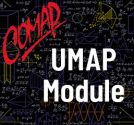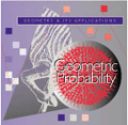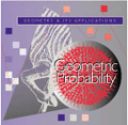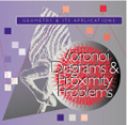Member Resources
COMAP offers members access to numerous mathematics and modeling programs, products, and materials in a variety of collections and formats. Our online library has more than 1500 resources. This page lists resources with most recent first. Please use the Search box or the filter options in the Find Resources menu to assist in locating desired products. For additional assistance or if you have questions, please don't hesitate to contact us.
Five Applications of Max - Min Theory from Calculus (UMAP)
With this module, the student will gain further knowledge of differentiation and optimization skills. Also, the stude...
Population Projection (UMAP)
This unit examines a model developed by P.H. Leslie and others that uses matrix multiplication to make population pro...
Error - Correcting Codes 1 (UMAP)
A unit that involves linear algebra with error-correcting codes. Within this module students will learn to: 1) use si...
Concepts of Math for Business: An Introduction to Basic Language for Computers (UMAP)
This module shows how to use a computer to solve simple problems in accounting, marketing and finance. It is self-con...
Interior Design: Preparing an Estimate (UMAP)
A unit that involves precalculus with the topic of preparing interior design professional cost estimates. Table of ...
Differentiation, Curve Sketching, and Cost Functions (UMAP)
The purpose of this module is for students to: 1) understand the way in which continuous functions are used to approx...
Evaluation of Diagnostic Tests and Decision Analysis (UMAP)
Students using this unit will be able to: 1) calculate the predictive value of a positive or negative test result in ...
Elementary Techniques of Numerical Integration (UMAP)
A unit that uses calculus and elementary techniques of numerical integration. By the end of this module students will...
Selected Applications of Mathematics to Finance and Investment (UMAP)
This module is an informal and largely elementary discussion of the background and uses of formulas for finance and i...
The Force of Interest (UMAP)
The purpose of this module is to give students an: 1) appreciation for a natural connection between exponential funct...
Integration: Getting It All Together (UMAP)
These units teach a strategy for solving problems in integration that has three steps: simplify, classify, and modify...
Mercator's World Map and the Calculus (UMAP)
A unit that applies calculus and trigonometry within the topic of Mercator's World Map. The history of Mercator's map...
Management of a Buffalo Herd (UMAP)
A unit that uses linear algebra in the topic of buffalo herd management. This module shows students how to: 1) calcul...
Economic Equilibrium: Simple Linear Models (UMAP)
This unit: 1) discusses the movement of prices due to shifts in supply and demand, and price equilibrium; 2) defines ...
Viscous Fluid (UMAP)
This module uses Poiseuille's Law to compute total flow of fluid through a pipe, sets up a moderately complicated int...
The Human Cough (UMAP)
The purpose of this module is to: 1) see how a phyiscal assumption may lead to a choice of domain for a function; 2) ...
Zipf's Law (UMAP)
From this module students will learn how to: 1) use partial fractions to explain summation; 2) calculate relative err...
The Alexander Horned Sphere (UMAP)
A unit that involves applications of introductory topology. The purpose of this module is for students to: 1) underst...
Kinetics of Single-Reactant Reactions (UMAP)
A unit that involves calculus in the topic of kinetics of single reactant reactions. This module: 1) describes single...
Radioactive Chains: Parents and Children (UMAP)
In this module equations for radioactive decay are set up and solved. The solution functions are graphed and equilibr...
Pi is Irrational (UMAP)
The purpse of this module is to prove that pi is irrational, and to discuss the fact briefly in the context of algebr...
The Wallis Appoximation of Pi (UMAP)
This module discusses some history of the approximation of pi. It also states and derives the Wallis formula for appr...
Buffon's Needle Experiment (UMAP)
A unit applying calculus to Buffon's needle experiment. With completion of this module students will: 1) understand t...
Strange Result in Visual Perception (UMAP)
A unit that applies calculus to physiology and psychology. This module shows how elementary calculus may be used to e...
Horner's Scheme and Related Algorithms (UMAP)
The unit introduces Horner's scheme for evaluating polynomials, and generalizes with ease to related algorithms for c...
Algorithms for Finding Zeros of Functions (UMAP)
This unit discusses methods for finding the zeros of real valued functions of a real variable. It begins with the cla...
The Impossibility of Trisecting Angles (UMAP)
One of the most intriguing geometrical problems of antiquity is to trisect an angle. Although E. Galois proved around...
Testing a Hypothesis: T-test for Independent Samples (UMAP)
This module presents a problem and its solution indicating the role of the statistical t-test of significance in the ...
Monte Carlo: The Use of Random Digits to Simulate Experiments (UMAP)
A unit that involves the use of random digits to simulate experiments. Students use the Monte Carlo technique to simu...
Lagrange Multipliers: Applications to Economics (UMAP)
This module introduces some of the applications of multivariable calculus to utility theory. The Lagrange multiplier ...
Geometric Probability (GeoMAP)
Through the visual world of geometry, students experience probability as a tangible issue, allowing them to more easi...
Geometric Probability - Teacher's Notes (GeoMAP)
Through the visual world of geometry, students experience probability as a tangible issue, allowing them to more easi...
Voronoi Diagrams & Proximity Problem (GeoMAP)
Many interesting problems in the real world can be thought of as proximity problems. In a proximity problem you are i...
Distribution of Resources (UMAP)
The people and the nations of the world own many resources: money, land, energy, food, oil, etc. One of the most impo...
Modeling the Nervous System: Reaction Time and the Central Nervous System (UMAP)
This module describes the process by which the central nervous system responds to a stimulus, and explains how this p...
Population Growth and the Logistic Curve (UMAP)
A unit that applies calculus to population growth. This module describes the mathematical assumptions that lead to th...
Find Resources
Browse More Resources
Search



